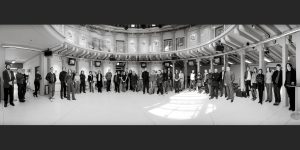U19
Sirikit Amann (AT)
Sirikit Amann studied political science, theater arts and economics in Austria, Germany and USA. Since 1987 she works for the ÖKS (Austrian Cultural Services) where she is responsible for the concept development and implementation of multimedia projects in schools.
Tina Auer (AT)
Tina Auer has worked since 1994 as a freelance artist. From 1994 to 1996 she was a member of the collective Contained; since 1996 she has been active as co-founder of the cultural association Time’s Up. In 2002 she finished her studies in experimental and visual design in Linz. Her fields of interest range from the functions and behaviours of people in general situations taken from everyday life and artificially established, to the universal and specific use and abuse of visual media of all kinds – as weil as everything in between.
Horst Hörtner (AT)
Horst Hörtner studied telematics at the Technical University in Graz and worked both as a developer of real-time control systems and for art projects. He was the co-founder of the group X-space and has also worked for the Seville EXPO, documenta IX, austromir, etc. Since 1995 he has been the technical director of the Ars Electronica Center in Linz.
Manfred Nürnberger (AT)
Manfred Nürnberger is partner of Hiebeler/Nürnberger GmbH, a consultant for interactive cross media formats. He is a pioneer in development and implementation of interactive media projects (amongst others Chello, Primacom, Alacatel). As a founder and CEO of ActiveAgent AG he helped develop the company to be the second largest advertisement-trader in Europe with branches in Austria, Germany, Switzerland and Hungary. Additionally the Master of Business Administration is author of numerous publications and – together with Christian Eigner – author of matching net, a standard work on the new-media-economy.
Martin Pieper (AT)
Martin Pieper is at present chief editor and radio announcer at FM4. For this man from Tulln, it was only a small step from passionate radio listener to radio-maker. In the first letter he ever sent to the Austrian Broadcasting Corporation (ORF), he pretentiously formu lated his desire for more good music. With the 24-hour station FM4 more than just this dream has come true. Via radio Ö3’s „Zick Zack“ and „Musicbox“, Martin Pieper joined the team founding FM4 in 1995. During this time he also aged years.
INTERACTIVE ART
Scott S. Fisher (US)
Scott S. Fisher is a media artist and interaction designer whose work focuses primarily on interactive environments and technologies of presence. Well known for his pioneering work in the field of Virtual Reality at NASA, Fisher’s media industry experience includes Atari, Paramount, and his own companies Telepresence Research and Telepresence Media. A graduate of MIT’s Architecture Machine Group (now Media Lab), he has taught at MIT, UCLA, UCSD, and is a Project Professor at Keio University in Japan. His work has been recognized internationally through numerous invited presentations, professional publications and in the popular media. In addition, he has been an Artist in Residence at MIT’s Center for Advanced Visual Studies and his stereoscopic imagery and artwork has been exhibited in the US, Japan and Europe.
Tomoe Moriyama (JP)
Tomoe Moriyama studied art history and received an MA degree at the University of Tsukuba. She participated in the Museum Preparation Office of Tokyo Metropolitan Government as a curator, during the doctoral course. Since 1989, she has organized over 30 exhibitions on media art and pre-cinema history including „Re-Imagination“, „3D-beyond the stereography“ and „UK98: electronically yours“ (with J. Reichardt) as a curator of Tokyo Metropolitan Museum of Photography. She is an invited researcher of the University of Tokyo, as well as a lecturer in media art at Waseda University in Tokyo, also its postgraduate course and several other colleges of art. She is a jury member of Digital Contents Grand-Prix of the Ministry of International Trade & Industry, and a member of the council of the Virtual Reality Society, Japan.
Joseph Paradiso (US)
Joseph Paradiso directs the MIT Media Lab’s Responsive Environments Group, which explores the development and application of new sensor technologies for human-computer interfaces and intelligent spaces that create new forms of interactive experience and expression. Over the course of his career, his work has encompassed high-energy physics detectors, spacecraft control systems, electronic sensors and electronic music instruments. He has a Ph.D. in physics from MIT and is the winner of a 2000 „Discover Magazine Award“ for Technical Innovation for his Expressive Footwear System. Background information and links to his projects can be found at web.media.mit.edu/~joep/.
Christiane Paul (US)
Christiane Paul is the Adjunct Curator of New Media Arts at the Whitney Museum of American Art and the director of Intelligent Agent, a service organization and information resource dedicated to digital art. She has written extensively on new media arts and has recently been working on a book about context and meaning in digital art with Victoria Vesna and Margot Lovejoy (to be published by MIT Press) and a book on Digital Art for the World of Art Series of Thames & Hudson, UK (to be published in 2003). She teaches in the MFA computer graphics department at the School of Visual Arts in New York and has lectured internationally on art and technology. Her first show at the Whitney, Data Dynamics (March-June 2001) dealt with the mapping of data and information flow on the Internet and in the museum space. She also curated the net art selection for the exhibition Evo1 (Gallery L, Moscow, October 2001), for Fotofest (Houston, Texas, March/April 2002) and the 2002 Whitney Biennial (March-May, 2002). She is responsible for Artport, the Whitney’s online portal to Internet art.
Stahl Stenslie (NL)
Stahl Stenslie is a p rofessor of experimental Media Art at the Media Academy of Cologne, Germany. He works with cognition and perception manipulative projects, spezializing in multi sensorial interfaces. He’s known as one of the Fathers of Cybersex after he built the world’s first full-body, tele-tactile communication systems in 1993 (cyberSM). His mating of man and machine has continued with the semantic god-machine (erotogod), currently with the world’s highest multi-sensory resolution. Stahl has been exhibiting and lecturing at major international events (lSEA, DEAF, Ars Electronica, SIGGRAPH). He represented Norway at the 5th biennial in Istanbul, Turkey, co-organized 6cyberconf (Oslo ’97), won the Grand Prize of the Norwegian Council for Cultural Affairs and moderated the Ars Electronica 2000 Symposium (Next Sex).
DIGITAL MUSICS
AGF aka Antye Greie (DE)
AGF aka Antye Greie is musician, producer, vocalist author, artist and currently living in Berlin. AGF became internationally known by recording herself reading lines of code and then deconstructing them into a sluice of broken syllables and bursts of breath. AGF takes what has been done before with DSP laptop electronics and turns it on its head – into electronic roar, subsonic beats, vocal processing, multilingual lyric sampling. Selected works: AGF / head slash bauch (orthlorng musork 2000, www.musork.com/o_08.html); laub / filesharing (kitty-yo 2001, www.laubfilesharing.de/) cooperation with Vladislav Delay / naima (staubgold 2001); sound installation berlin.klang (SONAR 2000, acoustic code of Berlin). Artist in residence at Podewil 2001 (Berlin contemporary centre); Quelle Berlin, a multimedia event based on source code of Berlin; sound installation audio.lab (Centre Pompidou 2003).
Naut Humon (US)
Naut Humon is the director of operations for the RECOMBINANT MEDIA LABS in San Francisco. This network of A/V based actions houses the Surround Traffic Control cinesonic system for performance exhibitions and international residencies. He is also producer and curator for the Asphodel label along with his own projects for speaker-screen installations.
Alain Mongeau (CA)
Alain Mongeau has been founder and artistic director of MUTEC and has directed the section of new media at the Festival international du nouveau Cinéma et des nouveaux Médias de Montréal (FCMM). Additionally he has curated the 6th International Symposium of Electronic Arts ISEA 95 in Montréal. He holds a PhD in communication from the Université de Ouébec in Montréal and has produced dozens of new media art projects that have been shown at festivals internationally. He has been granted fellowships from the Conseil des Arts du Canada (1997, 1992, 1990), the Ministère des Affaires Culturelles du Ouébec (1990) and the Fondation UOAM (1988). He travels a lot to watch the evolution of different streams of new media, digital culture and electronic music.
Marcus Schmickler (DE)
Marcus Schmickler is part of the electronic collective A-Musik, the homebase of acts like MOUSE ON MARS. On his new album, Jan St. Werner (Mouse on Mars, Microstoria) and Jaki Liebezeit (CAN) are involved with additional instruments (gongs, keyboards, drums). Render Bandits includes a large range of sound sources and a massive battery of drums. Marcus Schmickler himself and Jaki Liebezeit are responsible for the complexity of rhythms on the album. Pluramon is definitely in the tradition of the main German Krautrock band CAN, but neither is the sound of Pluramon a copy of the 70’s sound nor is the project part of the alternative post rock movement. The use of manipulated instruments like gongs, guitars and special keyboards is inspired by electroacoustic and electronic sources and becomes very percussive on the album. The amplification of sounds creates an immersive environment of acoustic space. The music emits massive soundwaves, sound which is always travelling, never arriving. Sound opens endless horizons and spaces which can be filled with analogies, myths and images.
David Toop (UK)
Oavid Toop is a musician, writer and sound curator. He has published three books, currently translated into six languages: Rap Attack, Ocean of Sound, and Exotica (selected as a winner of the 21st annual American Books Awards for 2000) . His first album, New and Rediscovered Musical Instruments, was released on Brian Eno’s Obscure label in 1975; since 1995 he has released six solo albums and curated five acclaimed CD compilations for Virgin Records. In 1998 he composed the soundtrack for Acqua Matrix, the Lisbon Expo, has recorded shamanistic ceremonies in Amazonas, appeared on Top Of The Pops with the Flying Lizards, worked with musicians including Brian Eno, John Zorn (among others). As a critic and columnist he has written for many publications. He has curated Sonic Boom. In 2001 -02 he was sound curator for Radical Fashion. Other recent projects include the composition of a soundtrack for Mondophrenetic and Needle In the Groove. Currently he is a Visiting Research Fellow at the Sound Department of the London Institute.
COMPUTER ANIMATION / VISUAL EFFECTS
Loren Carpenter (US)
Loren Carpenter, inventor of the CINEMATRIX Interactive Entertainment Systems® audience participation technology, holds multiple patents and has received numerous awards for inventing breakthrough computer imaging technologies such as RenderMan® to make three-dimensional animated movies like Toy Story, A Bug’s Life, Toy Story 2 and Monsters, Inc. possible. While attending the University of Washington for his studies in Mathematics and Computer Science, he was employed by The Boeing Company. Later he was part of the Lucasfilm Computer Division. Loren is currently Senior Scientist at PIXAR Animation Studios, creators of blockbuster animated feature films released by Disney.
Oliver Cauwet (FR)
Olivier Cauwet is digital animation supervisor at BUF compagnie. After having studied at Supinfocom (FR), where he co-directed the short movie Ombre portee (prix SACD imagina 98), he made his way through different companies in post-production in France as well as a participant in a news-illustration project at Agence France Presse. Since April 1998 he has been at BUF compagnie as an animator and animation supervisor on advertising projects, video clips and feature films like Fight Club, The Cell, Human Nature and most recently Panic Room.
Hiroshi Chida (JP)
Hiroshi Chida, born in 1968, graduated from the Musashino Art University, Department of Visual Communication Design. He spent two years with an advertising agency working as a graphic designer before joining Polygon Pictures in 1995. After spending time as a CG artist and art designer, he made his directional debut in a highly acclaimed TV commercial for a major Japanese cosmetic company, Shiseido, directing one of its award-winning Rocky & Hopper Hard Mousse commercial series. He has also co-directed the award winning TV animation short series, Mr. Digital Tokoro, in which he conceptualized, wrote, and directed 245 three-minute episodes with his partner, Masayoshi Imayoshi. He has since directed the new Polygon Family series, which was his wild and bold sequel to the highly acclaimed 1998 short subject Polygon Family, which brings 3D animation to a whole new spectrum, integrating 20 graphics and Japan imation techniques in a 3D environment. .
Bob Sabiston (US)
Bob Sabiston is a computer animator living in Austin, TX. He runs Flat Black Films, an animation company dedicated to producing independent short films. He was the animation director of Richard Linklater’s 2001 feature film Waking Life, which used his proprietary rotoscoping technology for animating on top of video footage. Bob is also the director of many short films including Yard, Snack and Drink and RoadHead. Most recently he and his team of animators have completed a short film segment for the Lars van Trier/Jorgen Leth film The Five Obstructions. In addition to doing a lot of the drawing, Bob writes all of the software used in Flat Black Film’s projects.
Rita Street (US)
Rita Street has been an editor for Film & Video Magazine and a Founder and President of the non-profit organization Women In Animation, Inc. She is also the author of the book Computer Animation: A Whole New World. She got her start in publishing at Animation Magazine and was later promoted to Publisher. She has been to SIGGRAPH several times and has published books worldwide. Besides her journalism job and her writing she has another big passion: rock climbing.
NET VISION / NET EXCELLENCE
Ed Burton (UK)
Ed Burton grew up playing with computer programming, with his first software title being published at the age of 17. Following a degree in Architecture at the University of Liverpool, Ed undertook the MA in Digital Arts at the Middlesex University Centre for Electronic Arts. His MA work on computer models of young children’s drawing behaviour was subsequently developed into an ongoing PhD research project into artificial intelligence, dynamic systems and developmental psychology. After three years of research and teaching at the Centre for Electronic Arts, Ed joined Soda in 1998 and was the original author of the Java toy sodaconstructor.
Joshua Davis (US)
Joshua Davis is a New York artist and technologist producing both public and private work on and off the Web. His site www.praystation.com was the winner of the 2001 Prix Ars Electronica Golden Nica in the category „Net Excellence“. He is currently an instructor at the School of Visual Arts in New York City and lectures globally on his work, inspirations and motivations.
Casey Reas (US)
Casey Reas recently obtained his MS degree in Media Arts and Sciences at the MIT Media Laboratory. His research at the MIT Media Lab’s Aesthetics and Computation Group concentrated on interface design, information design, and computational kinetic sculpture. The common thread in his work is the study of dynamic reactive systems that receive and process input as a means of generating and altering visual compositions. Before joining MIT, he worked as Design Director at leading web design companies in New York. He studied design at the University of Cincinnati in the USA.
Steve Rogers (GB)
Steve Rogers started his career in 1983 designing spectacles for Norville Optical Company. From there, he went on to work for Gillette on the Braun brand in the research labs. In 1986 he left England to work for Philips Electronics in Holland as a product designer. Continuing his career with Philips, he moved to Vienna in 1980 and to California in 1995. He spent a total of 15 years with Philips Design as Design Director. Before joining the BBC Rogers was VP, Physical Design at Razorfish digital consultancy in San Francisco. Here he had global responsibility for design of physical and service related products. In his first position at BBCi in August 2001 as Head of Design and Navigation, Rogers was responsible for the design and navigation team defining users‘ experience of BBCi on the web, interactive TV and emerging platforms. In September 2002 he has been appointed as Head of Production for BBCi. Rogers has a degree from Coventry University in Transportation Design.
Yukiko Shikata (JP)
Yukiko Shikata is an independent curator & critic based in Tokyo, working as associate curator of Mori Art Museum (MAM), guest curator of Shiseido CyGnet and specially-assigned professor at Tokyo Zokei University. Her works include projects at Canon ARTLAB (cocurator till 2001), Mischa Kuball Power of Codes-Space for Speech (Tokyo National Museum, 1999), PROTOCOLLISION (online, co-curated, 2000) Kingdom of Piracy (online, co-curated, 2001 – ) and OPEN MIND CD (MAM, 2002). She is curatorial committee member of eyebeam (NY) and international advisory board member of Transmediale (Berlin).



